Effects of Aeolian Sand and Water−Cement Ratio on Performance of a Novel Mine Backfill Material
Abstract
:1. Introduction
2. Experimental Scheme
2.1. Test Sample Design
2.2. Raw Materials
2.3. Test Sample Preparation
2.4. Testing Equipment and Instruments
3. Experimental Results and Discussion
3.1. Results of Vicat Needle Test
3.2. Failure Modes
3.3. Stress-Strain Curves
- (1)
- Pore compression stage: This stage was more clearly distinct in the pure high-water materials (e.g., U-1.0-00, U-1.5-00, and U-2.0-00); as the water−cement ratio increased, the stage of pore compression became even more distinct (Figure 7a,b). But for MBM specimens, the scene became less precise as the doping amount of aeolian sand increased (Figure 7c). It would appear that the specimens with a larger water−cement ratio had a more remarkable pore compression stage. At the same time, the higher sand content that led to this stage was not significant. It may be because the doped aeolian sand particles filled the pores between the originally pure high-water material, reducing the number and space of pores.
- (2)
- Elastic deformation stage: This stage became less distinct and had a shorter duration for pure high-water materials (Figure 7a) and a low doping amount of aeolian sand (Figure 7c). However, as the water−cement ratio increased, this stage became less precise and had a shorter period (Figure 7a,b). In addition, as the doping amount of aeolian sand increased (Figure 7c–e), this stage became more distinct and had a longer duration. This phenomenon mainly dominated in the modified material samples U-1.0-60. It may be assumed that the more considerable amount of aeolian sand doped into the high-water material, the smaller the pores between aggregate particles. The friction between the aggregate particles could further increase due to the cementing effect of the high-water materials. Therefore, the inter-particle dislocation was more unlikely to happen.
- (3)
- Yield stage: An apparent fracture plane appeared in the samples at this stage, and the fracture propagated constantly. At a higher doping amount of aeolian sand (Figure 7b–e), the failure occurred rapidly, resulting in a higher peak and more significant compressive strength on the curve at this stage. However, for pure high-water materials and samples doped with a small amount of aeolian sand (Figure 7a,c), the peak and the compressive strength were smaller on the curve. The above might be because the friction between the aggregate particles was lower due to the larger pores between them.
- (4)
- Failure stage: The MBM displayed significantly different features at this stage. The stress−strain curve showed a more gentle decreasing trend in the pure high-water materials (Figure 7c–e). However, the stress was still high even at the maximum strain, indicating a high residual strength (Figure 7a). Apparently, the decrease was steeper on the stress−strain curve for the MBM (Figure 7b–e). The stress corresponding to the maximum strain was lower in MBM than in pure high-water materials. Besides, this stress decreased as the doping amount of aeolian sand increased (Figure 7c). It would seem that although the post-peak strength decreased slightly, the MBM had high bearing capability after a large post-peak deformation.
3.4. Consumption of Raw Materials
4. Micromorphological Analysis
5. Conclusions
- (1)
- The initial setting time of the MBM decreased with the increased doping amount of aeolian sand and decreased with the water−cement ratio of the high water backfill material. It is thus possible to regulate the setting time of the MBM by changing the doping amount of aeolian sand to meet the technical requirements of the construction of RBB.
- (2)
- The typical stress−strain curve of the MBM consists of four portions: pore compression, elastic deformation, yield, and failure, indicating that the MBM is a typical elastoplastic material.
- (3)
- The MBM consistent with the high-water backfill material has the benefits of having high early strength, high flowability of single slurry, fast setting of mixed slurry, and high bearing capability after a large post-peak deformation.
- (4)
- Both the peak and the residual strength of the MBM increased with the doping amount of aeolian sand within a specific scope, which may be because the existence of the aeolian sand impacted the integrity and uniformity of the reticular structure of ettringite in the MBM.
- (5)
- Compared with the high-water backfill material, only limited cementitious material and water resources are requested to cast the RBB, which provides new insight for the application of the GER technique in arid, semi-arid deserts or Gobi mining areas.
Author Contributions
Funding
Institutional Review Board Statement
Informed Consent Statement
Data Availability Statement
Acknowledgments
Conflicts of Interest
References
- Bai, E.; Guo, W.; Tan, Y. Negative externalities of high-intensity mining and disaster prevention technology in China. Bull. Eng. Geol. Environ. 2019, 78, 5219–5235. [Google Scholar] [CrossRef]
- Xu, Y.; Shen, S.; Cai, Z.; Zhou, G. The state of land subsidence and prediction approaches due to groundwater withdrawal in China. Nat. Hazards 2008, 45, 123–135. [Google Scholar] [CrossRef]
- Bai, E.; Guo, W.; Tan, Y.; Huang, G.; Guo, M.; Ma, Z. Roadway Backfill Mining with Super-High-Water Material to Protect Surface Buildings: A Case Study. Appl. Sci. 2019, 10, 107. [Google Scholar] [CrossRef] [Green Version]
- Dong, L.; Shu, W.; Li, X.; Zhang, J. Quantitative evaluation and case studies of cleaner mining with multiple indexes considering uncertainty factors for phosphorus mines. J. Clean. Prod. 2018, 183, 319–334. [Google Scholar] [CrossRef]
- Dong, S.; Wang, H.; Guo, X.; Zhou, Z. Characteristics of Water Hazards in China’s Coal Mines: A Review. Mine Water Environ. 2021, 40, 325–333. [Google Scholar] [CrossRef]
- Wen, Q.; Li, J.; Mwenda, K.M.; Ervin, D.; Chatterjee, M.; Lopez-Carr, D. Coal exploitation and income inequality: Testing the resource curse with econometric analyses of household survey data from northwestern China. Growth Chang. 2022, 53, 452–469. [Google Scholar] [CrossRef]
- Wang, Y.; Chen, M.; Yan, L.; Zhao, Y.; Deng, W. A new method for quantifying threshold water tables in a phreatic aquifer feeding an irrigation district in northwestern China. Agric. Water Manag. 2021, 244, 106595. [Google Scholar] [CrossRef]
- Hu, S.; Ma, R.; Sun, Z.; Ge, M.; Zeng, L.; Huang, F.; Bu, J.; Wang, Z. Determination of the optimal ecological water conveyance volume for vegetation restoration in an arid inland river basin, northwestern China. Sci. Total Environ. 2021, 788, 147775. [Google Scholar] [CrossRef]
- Wang, G.; Xu, Y.; Ren, H. Intelligent and ecological coal mining as well as clean utilization technology in China: Review and prospects. Int. J. Min. Sci. Technol. 2019, 29, 161–169. [Google Scholar] [CrossRef]
- Huang, Y.; Wang, J.; Li, J.; Lu, M.; Guo, Y.; Wu, L.; Wang, Q. Ecological and environmental damage assessment of water resources protection mining in the mining area of Western China. Ecol. Indic. 2022, 139, 108938. [Google Scholar] [CrossRef]
- Dong, L.; Tong, X.; Li, X.; Zhou, J.; Wang, S.; Liu, B. Some developments and new insights of environmental problems and deep mining strategy for cleaner production in mines. J. Clean. Prod. 2019, 210, 1562–1578. [Google Scholar] [CrossRef]
- Dudka, S.; Adriano, D.C. Environmental impacts of metal ore mining and processing: A review. J. Environ. Qual. 1997, 26, 516–528. [Google Scholar] [CrossRef]
- Hilson, G.; Murck, B. Progress toward pollution prevention and waste minimization in the North American gold mining industry. J. Clean. Prod. 2001, 9, 405–415. [Google Scholar] [CrossRef]
- Song, S.; Liang, L.; Zhou, Y.; Wu, H.; Zhang, X. The situation and remedial measures of the cropland polluted by heavy metals from mining along the diaojiang river. Bull. Mineral. Petrol. Geochem. 2003, 22, 152–155. [Google Scholar]
- Zeng, Q.; Shen, L.; Yang, J. Potential impacts of mining of super-thick coal seam on the local environment in arid Eastern Junggar coalfield, Xinjiang region, China. Environ. Earth Sci. 2022, 79, 88. [Google Scholar] [CrossRef]
- Jiang, B.; Oh, K.; Kim, S. Technical evaluation method for physical property changes due to environmental degradation of grout-injection repair materials for water-leakage cracks. Appl. Sci. 2019, 9, 1740. [Google Scholar] [CrossRef] [Green Version]
- Ghasemi, E.; Shahriar, K. A new coal pillars design method in order to enhance safety of the retreat mining in room and pillar mines. Saf. Sci. 2012, 50, 579–585. [Google Scholar] [CrossRef]
- Esterhuizen, G.; Dolinar, D.; Ellenberger, J. Pillar strength in underground stone mines in the United States. Int. J. Rock Mech. Min. Sci. 2011, 48, 42–50. [Google Scholar] [CrossRef]
- Yang, K.; Zhao, X.; Wei, Z.; Zhang, J. Development overview of paste backfill technology in China’s coal mines: A review. Environ. Sci. Pollut. Res. 2021, 28, 67957–67969. [Google Scholar] [CrossRef]
- Zhao, H. State-of-the-art of standing supports for gob-side entry retaining technology in China. J. South. Afr. Inst. Min. Metall. 2019, 119, 891–906. [Google Scholar] [CrossRef]
- Chen, F.; Liu, J.; Zhang, X.; Wang, J.; Jiao, H.; Yu, J. Review on the Art of Roof Contacting in Cemented Waste Backfill Technology in a Metal Mine. Minerals 2022, 12, 721. [Google Scholar] [CrossRef]
- Zhu, X.; Guo, G.; Liu, H.; Chen, T.; Yang, X. Experimental research on strata movement characteristics of backfill-strip mining using similar material modeling. Bull. Eng. Geol. Environ. 2019, 78, 2151–2167. [Google Scholar] [CrossRef]
- Zhao, H.; Ren, T.; Remennikov, A. Standing support incorporating FRP and high water-content material for underground space. Tunn. Undergr. Space Technol. 2021, 110, 103809. [Google Scholar] [CrossRef]
- Prum, S.; Jumnongpol, N.; Eamchotchawalit, C.; Kantiwattanakul, P.; Sooksatra, V.; Jarearnsiri, T.; Passananon, S. Guideline for Backfill Material Improvement for Water Supply Pipeline Construction on Bangkok Clay, Thailand. In Proceedings of the 4th World Congress on Civil, Structural, and Environmental Engineering (CSEE’19), Rome, Italy, 7–9 April 2019. [Google Scholar]
- Xie, S.; Pan, H.; Chen, D.; Zeng, J.; Song, H.; Cheng, Q.; Xiao, H.; Yan, Z.; Li, Y. Stability analysis of integral load-bearing structure of surrounding rock of gob-side entry retention with flexible concrete formwork. Tunn. Undergr. Space Technol. 2020, 103, 103492. [Google Scholar] [CrossRef]
- Zhao, H.; Ren, T.; Remennikov, A. A hybrid tubular standing support for underground mines: Compressive behaviour. Int. J. Min. Sci. Technol. 2021, 31, 215–224. [Google Scholar] [CrossRef]
- Sun, Q.; Zhang, J.; Zhou, N. Study and discussion of short-strip coal pillar recovery with cemented paste backfill. Int. J. Rock Mech. Min. Sci. 2018, 104, 147–155. [Google Scholar] [CrossRef]
- Yan, B.; Ren, F.; Cai, M.; Qiao, C. Influence of new hydrophobic agent on the mechanical properties of modified cemented paste backfill. J. Mater. Res. Technol. -JmrT 2019, 8, 5716–5727. [Google Scholar] [CrossRef]
- Sun, H.; Liu, W.; Huang, Y.; Yang, B. The use of high-water rapid-solidifying material as backfill binder and its application in metal mines. In Proceedings of the 6th International Symposium on Mining with Backfill, Brisbane, Australia, 14–16 April 1998. [Google Scholar]
- Li, H.; Guo, G.; Zhai, S. Mining scheme design for super-high water backfill strip mining under buildings: A Chinese case study. Environ. Earth Sci. 2016, 75, 1017. [Google Scholar] [CrossRef]
- Li, G.; Liu, H.; Deng, W.; Wang, H.; Yan, H. Behavior of CFRP-Confined Sand-Based Material Columns under Axial Compression. Polymers 2021, 13, 3994. [Google Scholar] [CrossRef]
- Zhang, Z.; Deng, M.; Bai, J.; Yan, S.; Yu, X. Stability control of gob-side entry retained under the gob with close distance coal seams. Int. J. Min. Sci. Technol. 2021, 31, 321–332. [Google Scholar] [CrossRef]
- Wu, Y.; Gong, P.; Liu, Q.; Chappell, A. Retrieving photometric properties of desert surfaces in China using the Hapke model and MISR data. Remote Sens. Environ. 2009, 113, 213–223. [Google Scholar] [CrossRef]
- Zhao, Y.; Taheri, A.; Karakus, M.; Chen, Z.; Deng, A. Effects of water content, water type and temperature on the rheological behaviour of slag-cement and fly ash-cement paste backfill. Int. J. Min. Sci. Technol. 2020, 30, 271–278. [Google Scholar] [CrossRef]
- Kwak, M.; James, D.; Klein, K. Flow behaviour of tailings paste for surface disposal. Int. J. Miner. Process. 2005, 77, 139–153. [Google Scholar] [CrossRef]
- Wu, D.; Fall, M.; Cai, S. Coupling temperature, cement hydration and rheological behaviour of fresh cemented paste backfill. Miner. Eng. 2013, 42, 76–87. [Google Scholar] [CrossRef]
- Wu, D.; Cai, S.; Huang, G. Coupled effect of cement hydration and temperature on rheological properties of fresh cemented tailings backfill slurry. Trans. Nonferrous Met. Soc. China 2014, 24, 2954–2963. [Google Scholar] [CrossRef]
- Paterson, A. Pipeline transport of high density slurries: A historical review of past mistakes, lessons learned and current technologies. Min. Technol. Trans. Inst. Min. Metall. 2012, 12, 37–45. [Google Scholar] [CrossRef]
- Wu, A.; Wang, Y.; Wang, H.; Yin, S.; Miao, X. Coupled effects of cement type and water quality on the properties of cemented paste backfill. Int. J. Miner. Process. 2015, 143, 65–71. [Google Scholar] [CrossRef]
- Huynh, L.; Beattie, D.; Fornasiero, D.; Ralston, J. Effect of polyphosphate and naphthalene sulfonate formaldehyde condensate on the rheological properties of dewatered tailings and cemented paste backfill. Miner. Eng. 2006, 19, 28–36. [Google Scholar] [CrossRef]
- Qian, Y.; Kawashima, S. Distinguishing dynamic and static yield stress of fresh cement mortars through thixotropy. Cem. Concr. Compos. 2018, 86, 288–296. [Google Scholar] [CrossRef]
- Song, C.; Chen, K.; Wang, H. The Mechanism of hydration and hardening reaction of high-water material. Bull. Mineral. Petrol. Geochem. 1999, 18, 261–263. [Google Scholar]
- ASTMC136/C136M; Standard Test Method for Sieve Analysis of Fine and Coarse Aggregates. American Society for Testing and Materials: West Conshohocken, PA, USA, 2014.
- GB/T1346-2001; Test Methods for Water Requirement of Normal Consistency, Setting Time and Soundness of the Portland Cement. The Standards Press of China: Beijing, China, 2001.
- ASTMD7012-2010; Standard Test Method for Compressive Strength and Elastic Moduli of Intact Rock Core Specimens under Varying States of Stress and Temperatures. American Society for Testing and Materials: West Conshohocken, PA, USA, 2010.
- Zhang, Z.; Bai, J.; Chen, Y.; Yan, S. An innovative approach for gob-side entry retaining in highly gassy fully-mechanized long wall top-coal caving. Int. J. Rock Mech. Min. Sci. 2015, 8, 1–11. [Google Scholar] [CrossRef]


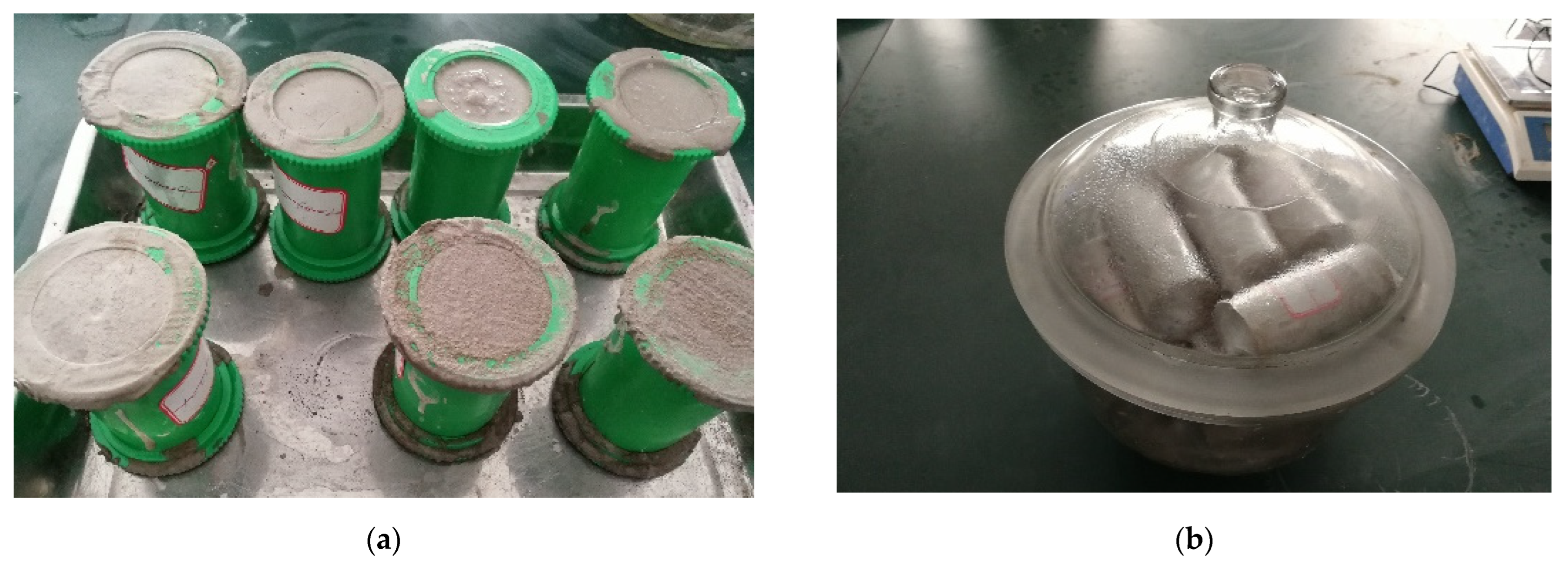
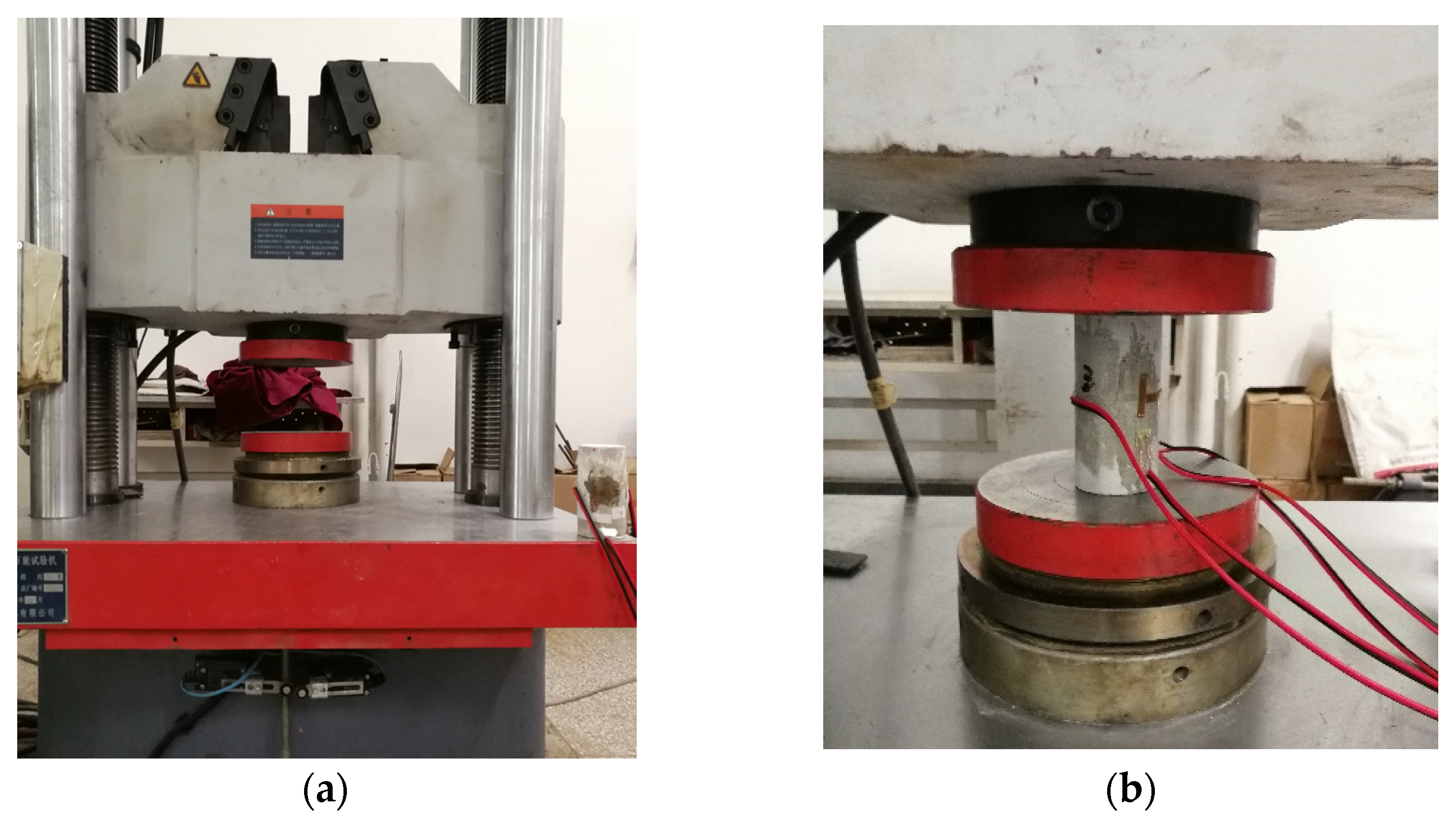


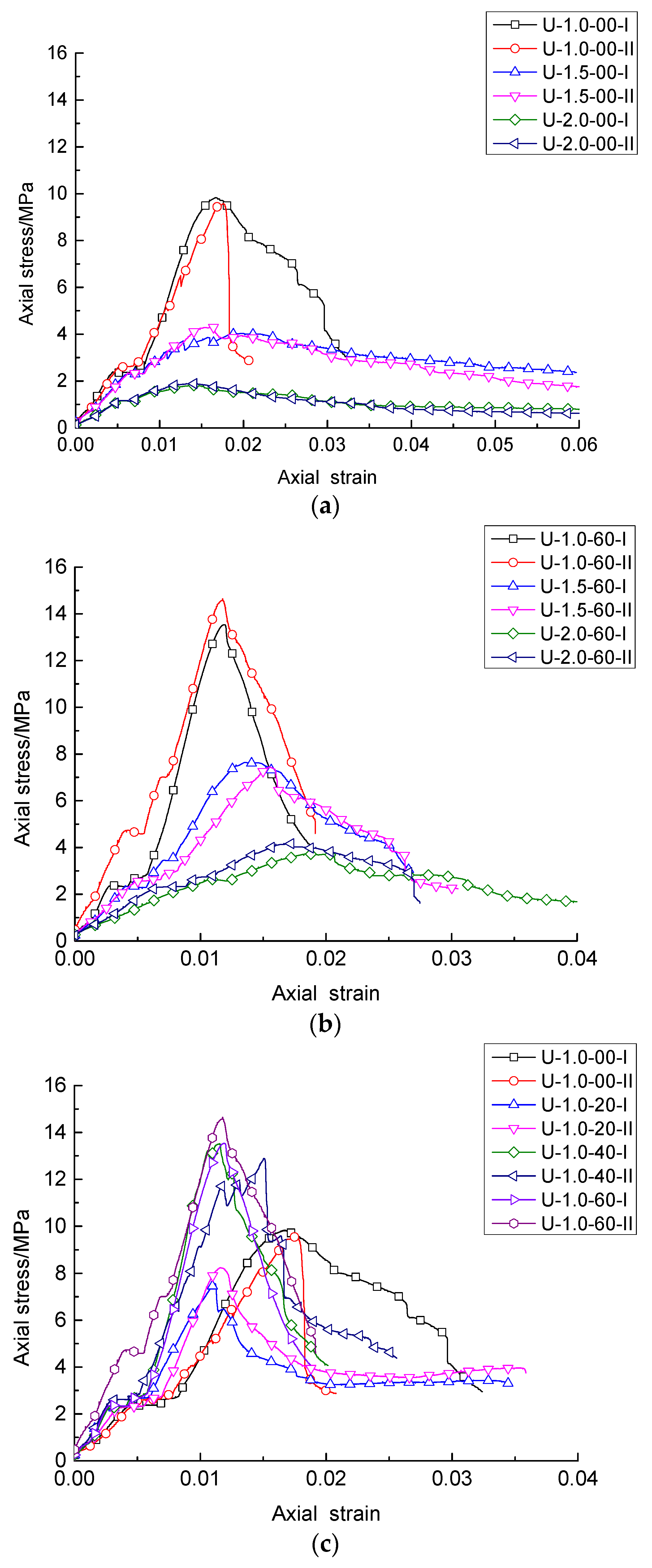
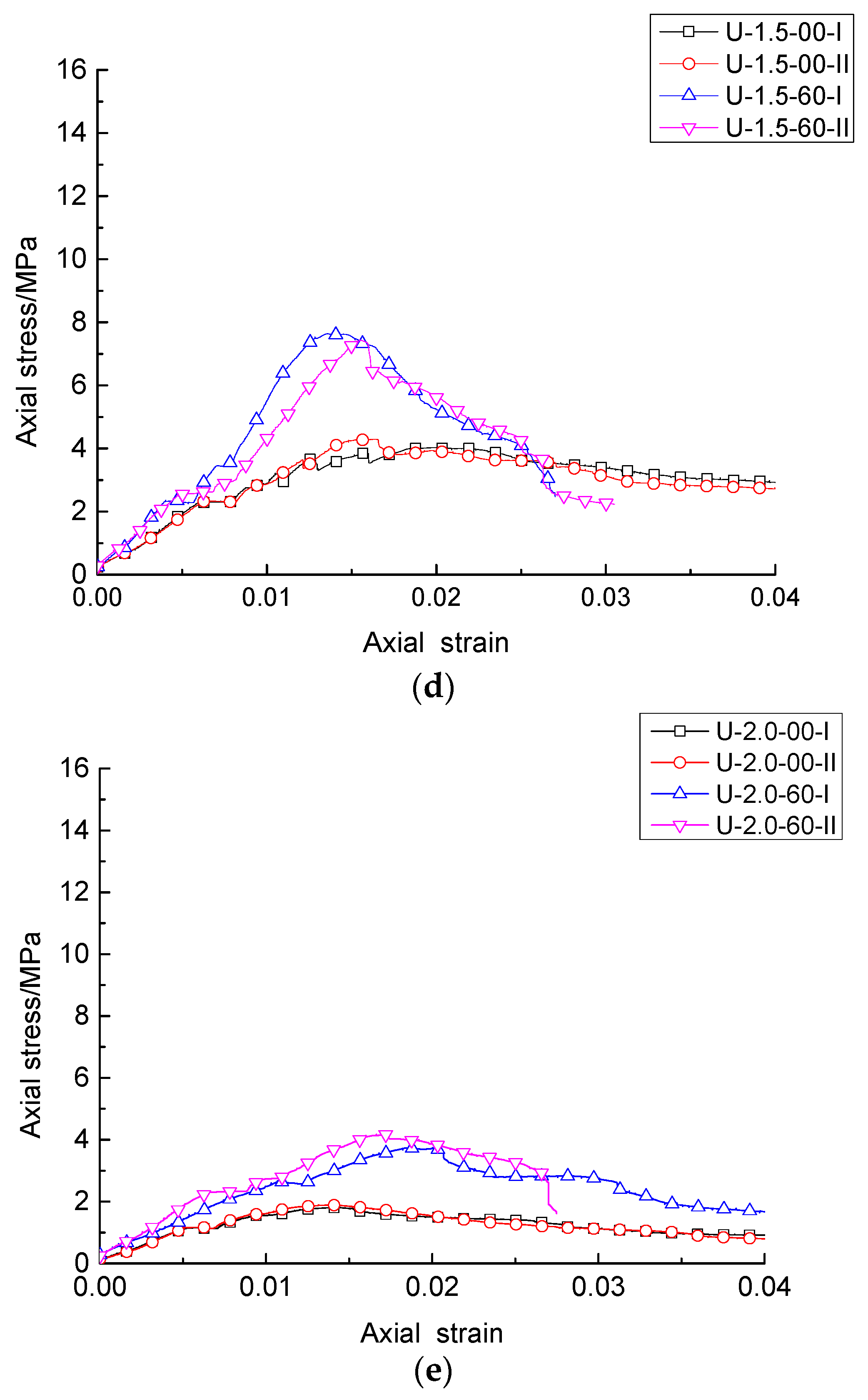
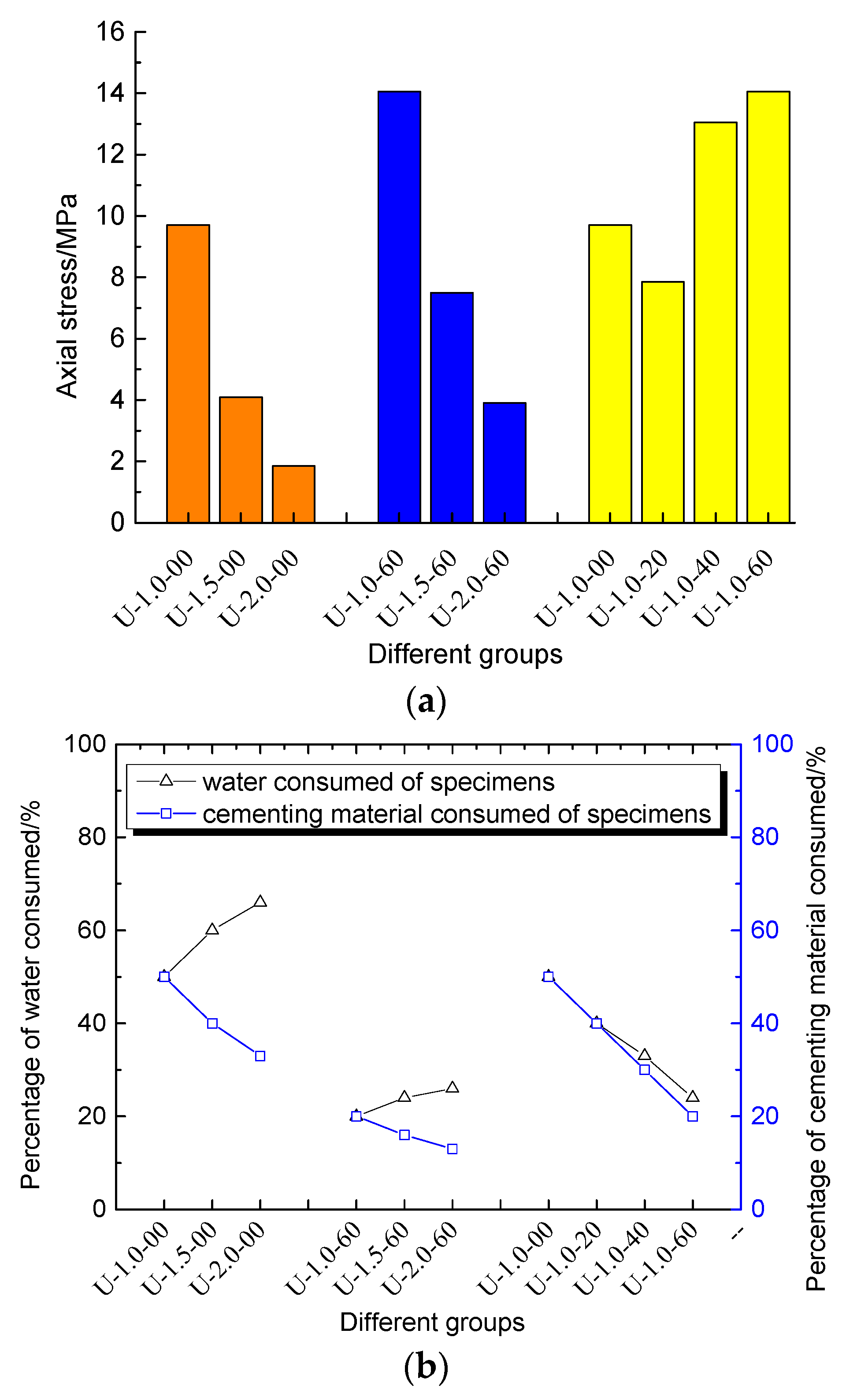
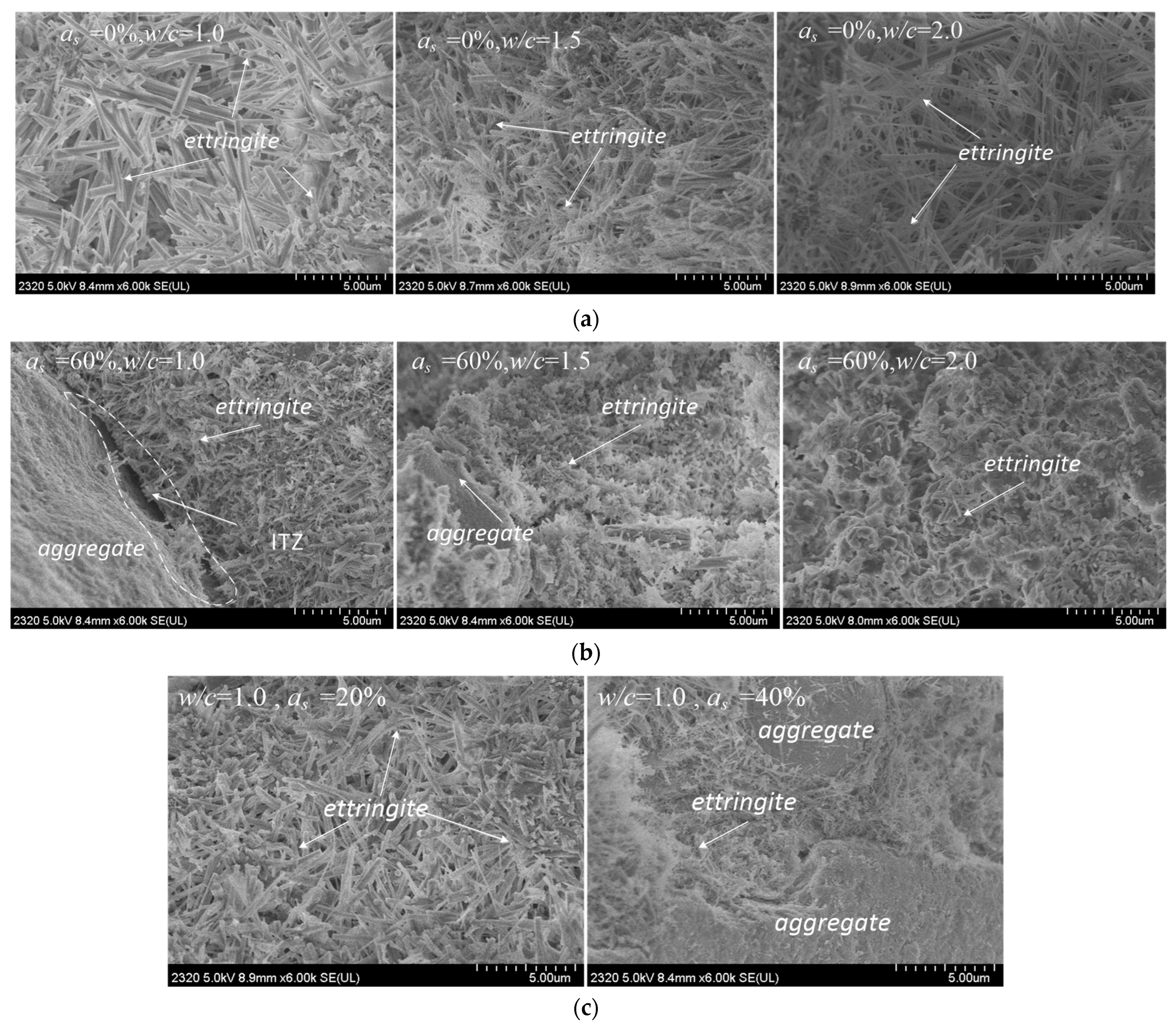
| Series | Group | Specimen | Water−Cement Ratio (w/c) | Sand Content (as) |
|---|---|---|---|---|
| 1 | U-1.0-00 | U-1.0-00-I,II | 1.0 | 0% |
| U-1.5-00 | U-1.5-00-I,II | 1.0 | 0% | |
| U-2.0-00 | U-2.0-00-I,II | 1.0 | 0% | |
| 2 | U-1.0-60 | U-1.0-60-I,II | 1.0 | 60% |
| U-1.5-60 | U-1.5-60-I,II | 1.5 | 60% | |
| U-2.0-60 | U-2.0-60-I,II | 2.0 | 60% | |
| 3 | U-1.0-00 | U-1.0-00-I,II | 1.0 | 0% |
| U-1.0-20 | U-1.0-20-I,II | 1.0 | 20% | |
| U-1.0-40 | U-1.0-40-I,II | 1.0 | 40% | |
| U-1.0-60 | U-1.0-60-I,II | 1.0 | 60% |
Disclaimer/Publisher’s Note: The statements, opinions and data contained in all publications are solely those of the individual author(s) and contributor(s) and not of MDPI and/or the editor(s). MDPI and/or the editor(s) disclaim responsibility for any injury to people or property resulting from any ideas, methods, instructions or products referred to in the content. |
© 2022 by the authors. Licensee MDPI, Basel, Switzerland. This article is an open access article distributed under the terms and conditions of the Creative Commons Attribution (CC BY) license (https://creativecommons.org/licenses/by/4.0/).
Share and Cite
Li, G.; Wang, H.; Liu, Z.; Liu, H.; Yan, H.; Liu, Z. Effects of Aeolian Sand and Water−Cement Ratio on Performance of a Novel Mine Backfill Material. Sustainability 2023, 15, 569. https://doi.org/10.3390/su15010569
Li G, Wang H, Liu Z, Liu H, Yan H, Liu Z. Effects of Aeolian Sand and Water−Cement Ratio on Performance of a Novel Mine Backfill Material. Sustainability. 2023; 15(1):569. https://doi.org/10.3390/su15010569
Chicago/Turabian StyleLi, Guodong, Hongzhi Wang, Zhaoxuan Liu, Honglin Liu, Haitian Yan, and Zenwei Liu. 2023. "Effects of Aeolian Sand and Water−Cement Ratio on Performance of a Novel Mine Backfill Material" Sustainability 15, no. 1: 569. https://doi.org/10.3390/su15010569






